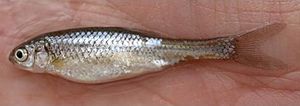Rio Grande silvery minnow facts for kids
Quick facts for kids Rio Grande silvery minnow |
|
|---|---|
 |
|
| Conservation status | |
| Scientific classification | |
| Synonyms | |
|
The Rio Grande silvery minnow (Hybognathus amarus) is a small fish found in North America. It mostly eats plants. This minnow is part of the cyprinid family, which includes many types of minnows and carps.
This little fish is one of the most endangered fish in North America. The U.S. Fish and Wildlife Service (USFWS) listed it as endangered in 1994. Today, you can find it in less than 5 percent of its original home in the Rio Grande. Long ago, these minnows lived all the way from Española, New Mexico, down to the Gulf of Mexico in Texas. Now, they only live in a small part of the river between the Cochiti Dam and the Elephant Butte Reservoir.
Contents
What Does It Look Like?
The Rio Grande silvery minnow is a sturdy, silver-colored fish. It has small eyes and a small mouth. Adult minnows can grow to be about 3.5 inches long. That's roughly the length of a credit card!
Diet and Behavior
Rio Grande silvery minnows are herbivores, meaning they eat plants. Scientists believe they eat river plants and small creatures that live on the river bottom. There hasn't been much research on their diet because it's hard to study what's in their tiny stomachs.
These minnows help keep the water clean by eating unwanted algae. They usually swim close to the bottom of rivers and streams. They also lay many eggs, which helps them survive. Silvery minnows are an important food source for other animals in the river.
Life Cycle and Reproduction
The eggs of the Rio Grande silvery minnow hatch very quickly, in about 24 hours. The baby fish, called larvae, can swim just 3 to 4 days after hatching. This fast growth helped the species thrive for a long time. They once lived across 3,000 miles (4,825 kilometers) of winding rivers from New Mexico to Texas.
Why the Minnow is Endangered
The Rio Grande silvery minnow was officially listed as an endangered species on July 20, 1994. Its population has dropped a lot because of changes to the Rio Grande over the last 100 years.
Here are some main reasons for their decline:
- Water Use: A lot of river water is taken for cities and farms.
- Changed Water Flow: Dams and canals have changed the natural flow of the river. This means there are no longer big spring floods that tell the minnows when to lay their eggs.
- Habitat Loss: The river has become narrower and straighter in some places. Dams also block the minnows from moving to different parts of the river.
- Water Pollution: The river water has become polluted. This pollution comes from waste from factories, military bases, and wastewater from towns and cities.
Even after being listed as endangered in 1994, the minnow's numbers have continued to fall. Its population is now much smaller than it was then.
Helping the Rio Grande Silvery Minnow
Many groups are working to save the Rio Grande silvery minnow.
Collecting Eggs and Raising Minnows
In 2000, the U.S. Fish and Wildlife Service started a project to save minnow eggs. Biologists collect minnow eggs and adult minnows near Elephant Butte. They make sure not to disturb other minnow groups upstream.
The adult minnows are then encouraged to lay eggs at special facilities. These places include the Albuquerque Biological Park and the Service's New Mexico Fishery Resources Office. The baby fish are either put back into the Rio Grande or kept to have more babies in captivity.
The Silvery Minnow Refugium
A special place called a "refugium" was built to help raise endangered Rio Grande silvery minnows. It was designed by Van H. Gilbert Architect PC and FishPro. This facility is at the City of Albuquerque's Biological Park.
The refugium has a large outdoor pond that holds 50,000 gallons of water. It also has a 3,500 square foot building with many aquarium tanks. These tanks hold tens of thousands of tiny baby minnows, each less than a sixth of an inch long.
The outdoor pond is shaped like a donut and varies in depth from one inch to two feet. Pumps control the water current to make it feel like the natural flow of the Rio Grande. The bottom of the pond is made of sand, gravel, and silt, just like a real riverbed.
The goal of this facility is to produce many minnows. For example, they aimed to produce 50,000 minnows in one year. Half of these would be released into the river, and the other half would stay for future breeding. They have actually produced even more than their goal! This project has won awards for its design and conservation efforts.
Legal Efforts to Protect the Minnow
Different groups have taken legal action to help protect the Rio Grande silvery minnow. These actions aim to make sure that river management follows laws like the Endangered Species Act. Over time, agreements have been made to try and improve the minnow's remaining habitat.
See also
 In Spanish: Carpa chamizal para niños
In Spanish: Carpa chamizal para niños


